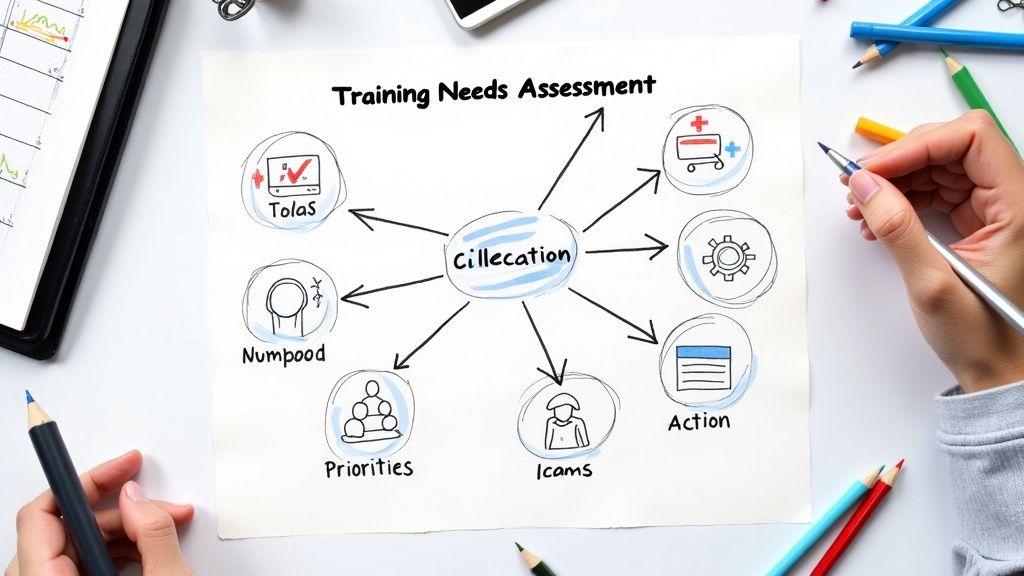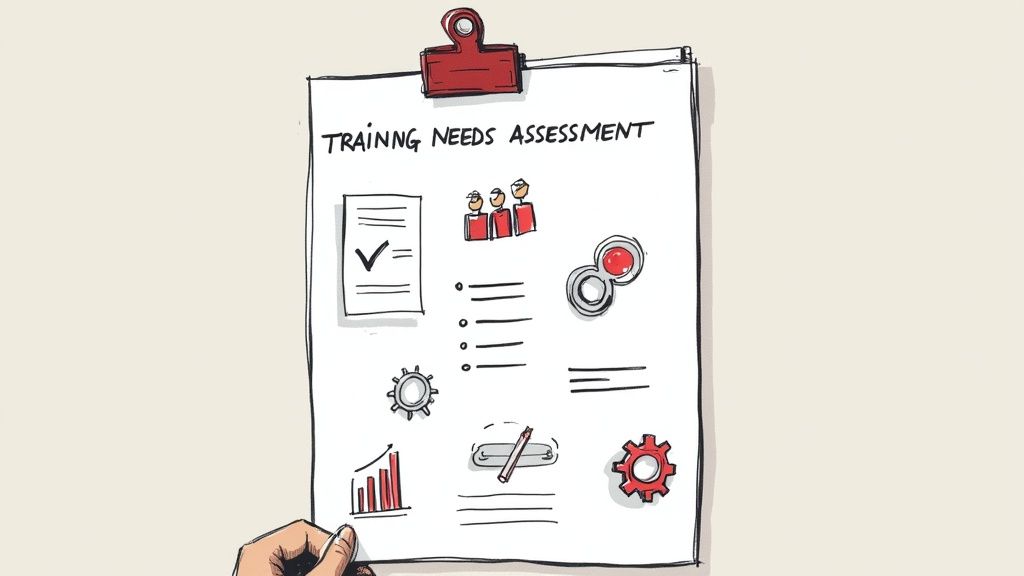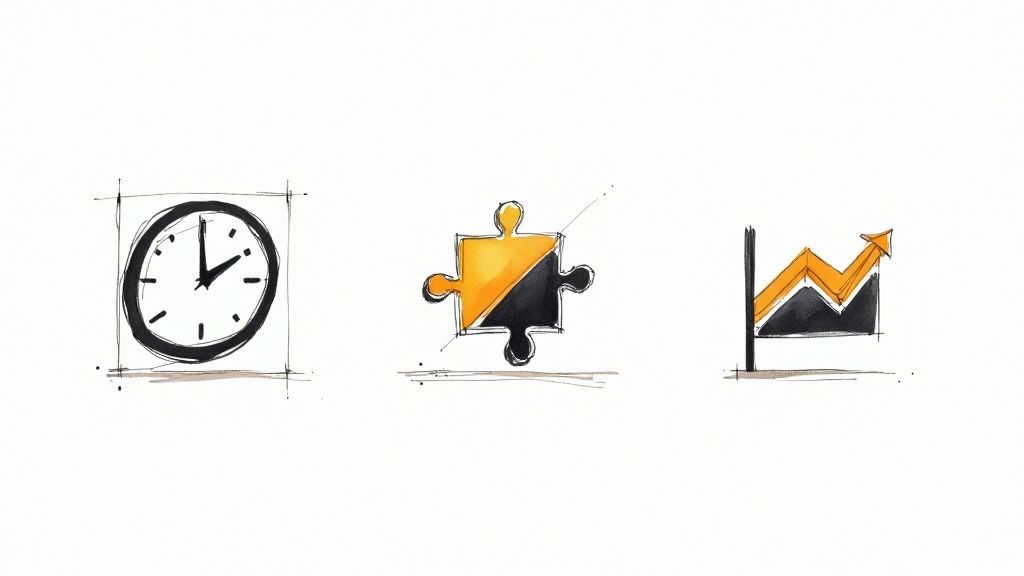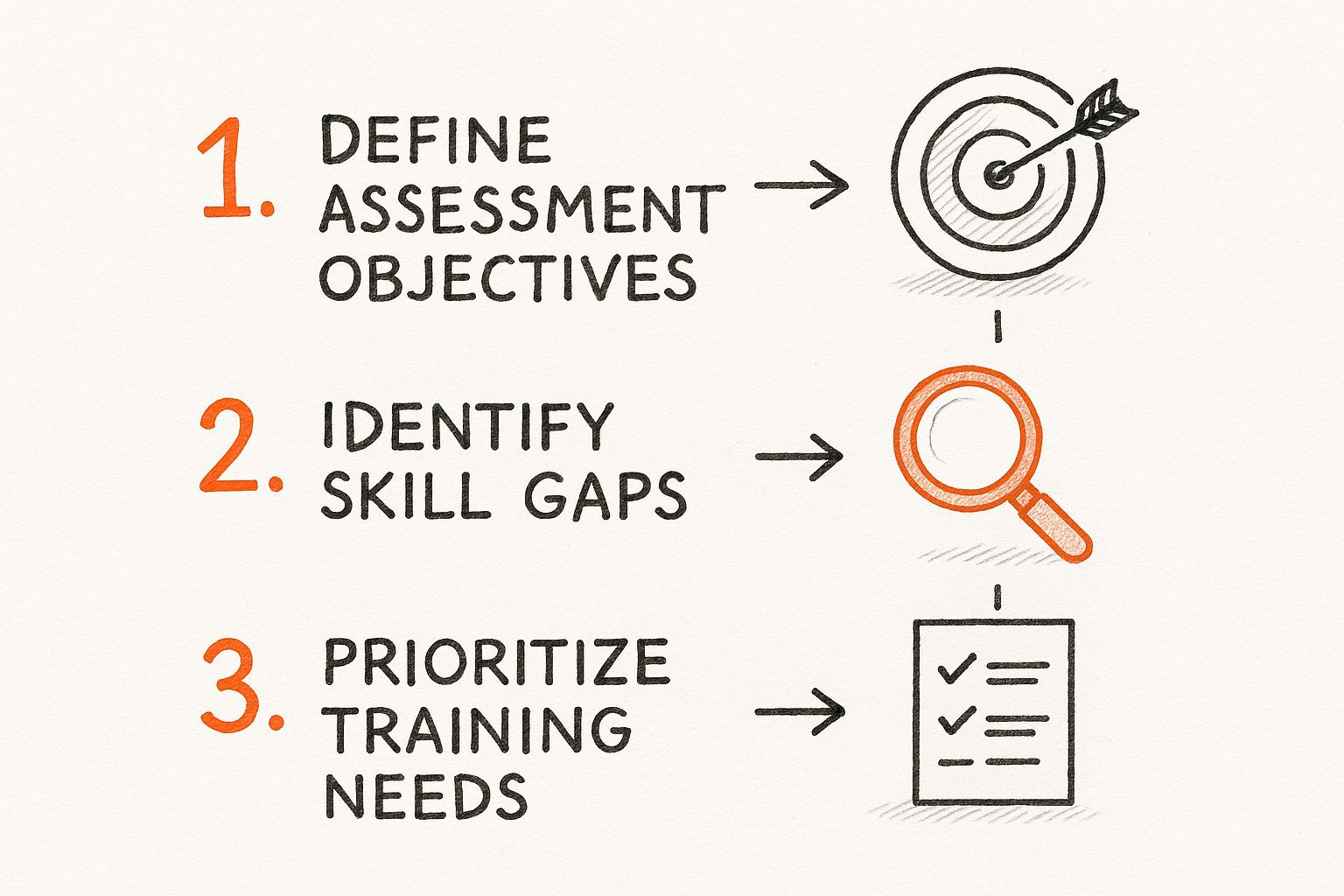
A training needs assessment template is supposed to be your roadmap for figuring out where your team has skill and knowledge gaps. It's a structured way to compare where your people are now versus where you need them to be, so you can build training that actually hits the mark.

Sure, a quick search will land you dozens of free "training needs assessment" templates. The problem is, most are just glorified checklists. They feel like a shortcut, but a one-size-fits-all approach is a recipe for lackluster results in any modern company.
These basic forms completely miss the point. They can't possibly grasp your specific business goals, your unique company culture, or the real-world challenges your teams are wrestling with every single day.
What happens next is predictable: you collect surface-level data that leads to generic, ineffective training. It's the reason so many corporate training programs feel totally disconnected from what people actually do on the job—they were built on a foundation of shallow insights.
A simple form won't tell you why a performance gap exists. Is your team struggling because they lack a technical skill in a tool like Adobe Captivate? Or is the real issue a breakdown in communication or a need for stronger leadership?
A generic template just asks, "What training do you need?" instead of digging deeper to uncover the root cause. This lazy approach almost always leads to wasted time and money on training that doesn't solve the core problem. If you're serious about strategic workforce readiness, you have to move beyond just checking a box for compliance and start uncovering the exact skills that will make a real difference.
It's easy to see why a quick template feels appealing, but the difference in outcomes is massive. A customized process is less about filling out a form and more about a strategic investigation into your team's potential.
Ultimately, a generic template is a box-ticking exercise. A customized assessment is a strategic tool that drives real business impact.
Modern learning isn't static. It's dynamic, blending smart technology with proven instructional theory, and that demands a much more thoughtful assessment process. With the rise of AI-driven Learning Experience Platforms (LXPs) and the shift toward microlearning, we need a deep understanding of what each person actually needs. An LXP can create personalized learning paths, but only if it's fueled by quality data about specific skill gaps.
A customized assessment is the engine that powers a modern learning ecosystem. It ensures that every piece of content—from a quick microlearning video to an interactive module built in the Articulate Suite—is directly mapped to a validated business need.
The whole point of a Training Needs Assessment (TNA) is to systematically identify these gaps and align learning with business goals. As detailed in a TNA process overview on deel.com, a solid approach involves talking to stakeholders, analyzing performance, and then designing solutions that fit. This turns your training budget from a simple operational expense into a genuine strategic investment.

Before you even touch a template or write a single question, let’s talk about groundwork. A lot of people get excited and jump right into the weeds, but that's like building a house without a blueprint. You’ll end up with a shaky foundation and a lot of wasted effort.
The whole point of a training needs assessment is to get clear, actionable insights—not just a mountain of data you don't know what to do with. That starts with figuring out what success actually looks like for your business. You have to tie your assessment to a real problem you're trying to solve.
Vague goals like "improving skills" won't get you anywhere. You need to get specific. What's the real target?
These are the kinds of concrete goals that give your assessment a clear purpose.
Getting your leadership team on board is about more than just a quick email approval. You need them to be genuinely invested. That happens when they understand the why behind your assessment and see it as a direct solution to a problem they actually care about.
So, don't just say, "We need to do a training assessment." That’s a surefire way to get a lukewarm response.
Instead, frame it in terms of business impact. Try something like, "If we're going to hit our Q3 sales targets, we need to pinpoint what's holding the sales team back. This assessment will tell us exactly where to focus our coaching so we can fix it." See the difference? Now it’s a strategic move, not just another L&D task.
Getting real support means connecting your assessment to the KPIs leadership is judged on. When they see a straight line from your project to their success, you get a true partner, not just a sponsor.
With leadership on your side, the next step is to bring in the people who are living the challenges every day. This means talking to department managers, high-performing employees, and even the folks who seem to be struggling the most. Their perspective is gold.
These initial conversations are where you'll find the real story. They’ll help you understand the nuances that data alone can't show.
This whole planning phase is a fundamental part of any good instructional design process. If you're interested in how this fits into the bigger picture, our guide on the ADDIE model for training at https://relevant.training/blog/addie-model-training does a great job of explaining how proper analysis is the bedrock of any successful training program.
By getting input from the right people early on, you can make a smart, strategic decision about which teams or roles to focus on first to get the biggest bang for your buck.
Relying on a single survey to understand what your team needs is like trying to map out a city by only walking down one street. You’ll see what’s there, but you’ll miss the bigger picture—the culture, the traffic flow, the hidden gems. A truly effective training needs assessment template can’t just collect data; it needs to gather the right data from multiple sources to create a complete, 360-degree view of your company’s skills.
Think of yourself as a skills detective. You're piecing together clues from different sources to solve the puzzle of what your teams really need to succeed. Each method you use uncovers another layer of the story.
This image lays out the journey perfectly, from setting your goals all the way to pinpointing the most critical training needs.

As you can see, every step builds on the last. This ensures your data collection isn't just busy work—it's a focused effort that leads directly to training that makes a real difference.
Different tools are good for different things. Sometimes you need a wide-angle lens, and other times you need a microscope. The data backs this up: a mixed approach is always best. Questionnaires and surveys are incredibly popular, used in about 80% of assessments because they scale so easily.
But numbers don't tell the whole story. That's why around 45% of organizations use direct observation to see how work actually gets done, and nearly 50% of HR teams sit down for one-on-one interviews to get the details you just can't capture in a multiple-choice question. You can dive deeper into these methods in a comprehensive analysis on aihr.com.
Here are some of the go-to methods I’ve seen work best:
Choosing the right mix of tools can feel overwhelming. This table is a quick cheat sheet to help you decide which method fits your situation best.
Ultimately, the best approach is a blended one. You're aiming for a complete picture, and each method provides a different piece of the puzzle.
The most powerful insights come from combining the quantitative data from surveys with the rich, qualitative stories you get from interviews and observation. The numbers tell you what is happening; the stories tell you why.
When you combine these techniques, you're doing more than just collecting information. You're building a narrative about where your workforce is now and where it has the potential to go. This lines up perfectly with core instructional design best practices, which always start with deeply understanding the learner. Your whole data-gathering process should feel less like a formal audit and more like a collaborative mission to uncover potential.

Alright, this is where the magic happens. We're moving from a generic idea to a practical tool that actually gets you the answers you need. Crafting the right questions for your training needs assessment template is more art than science. It's about digging deeper than surface-level "yes" or "no" responses to find out what's really going on with performance.
To get data you can actually use, you need to look at your company from three different altitudes: the 30,000-foot organizational view, the on-the-ground team view, and the up-close individual view. Each of these perspectives needs its own set of questions to uncover specific challenges and opportunities.
For a masterclass in this multi-level approach, check out the framework used by National Statistical Offices. They built a tool with three different questionnaires covering over 150 skills, which lets them find gaps at every level. It's incredibly thorough and helps them make smarter decisions on everything from formal training to one-on-one coaching. You can learn more about this statistical training needs assessment tool on the UN's website.
Let's start at the top. At this level, you’re essentially a fortune-teller. Your questions should be all about the future and connecting today’s skills with where the company needs to be in the next one to three years. Forget the day-to-day for a moment; this is about strategic readiness.
Think about the big changes on the horizon and ask yourself if your workforce is ready to handle them.
These questions make you think big picture, ensuring your training plan isn’t just patching holes but building a bridge to the future.
Now, let's zoom in a bit to how your teams function. Team-level questions should get at the heart of collaboration, communication, and the processes that hold everything together. This is where you find the little snags and friction points that can bring an entire department to a crawl.
Your goal here is to find the bottlenecks that aren't any one person's fault but are holding everyone back.
A well-crafted team question exposes systemic problems. It changes the conversation from "Who isn't pulling their weight?" to "What part of our process is broken?"
Try asking questions that peek into daily operations and team dynamics:
The answers you get here will point you directly to needs like process improvement training, communication workshops, or simply learning how to use the tech you already pay for.
Finally, it's time to get personal. Individual-level questions are about a person's specific technical abilities and the soft skills that make them successful. This is the perfect place for self-assessment, as it gives employees a chance to think about their own skills and where they want to grow.
I always recommend splitting these questions into two buckets:
When you cover all three of these levels, your custom training needs assessment template transforms into a powerful, dynamic tool. You'll end up with a rich, multi-layered picture that helps you build a training plan that's not just targeted but also perfectly aligned with where the entire organization is headed.
So, you’ve used your custom training needs assessment template and now you're sitting on a mountain of data. Great. But that's just the first step. Raw data on its own is just noise; the real magic happens when you turn those survey results and interview notes into a concrete training roadmap that actually moves the needle.
First things first, you need to play detective. Start sifting through your findings and look for the patterns. Are the biggest skill gaps all popping up in one department? Maybe everyone, from marketing to engineering, needs to get better at project management. You're trying to find the story your data is telling you about where your company is strong and where it's stumbling.
Once you have a handle on the main themes, it's time to get ruthless with prioritization. Let's be honest, you can't fix everything at once.
The skill gaps that matter most are the ones standing directly in the way of your biggest business goals. If you’re trying to crush your revenue targets, your sales team's weak negotiation skills are a much bigger fire to put out than a minor inefficiency in some internal software.
With your priorities locked in, you can start playing matchmaker between the problem and the right solution. This is where you get to blend solid instructional design with some pretty powerful modern tools. Your Learning Management System (LMS) or Learning Experience Platform (LXP) is your delivery truck, but the cargo—the actual training content—has to be right for the job.
Here are a few real-world examples of how this looks in practice:
Urgent, Widespread Knowledge Gaps: Let's say a new compliance policy just dropped and everyone needs to be up to speed, like, yesterday. For simple, fact-based stuff like this, you can use an AI-powered tool to whip up a series of short, snappy microlearning videos in minutes. Push them out through your LXP, and you've got a quick, effective solution.
Complex Behavioral Skills: You can't teach leadership or conflict resolution with a five-minute video. For these stickier, more nuanced skills, you need something more immersive. This is the perfect time to build out an interactive branching scenario using authoring tools like the Articulate Suite or Adobe Captivate.
Targeted Technical Skills: What if just a handful of engineers need to master a new piece of software? A curated learning path inside your LXP is the way to go. You can pull together a mix of vendor tutorials, live webinars with an in-house expert, and some hands-on projects to create a really comprehensive learning journey.
Ultimately, all this work boils down to creating one clear, actionable document: your training roadmap. This isn't just a shopping list of courses. It’s a strategic plan that details who gets trained on what, by when, and—most importantly—how you'll know if it actually worked.
When you lay out your training initiatives this way, you're not just scheduling classes; you're building a system for growth. To really nail this, it helps to ground your plan in a competency-based training approach, which ties every single learning activity back to a specific, measurable skill.
Your final roadmap should spell out these key elements:
Still have a few questions about making a training needs assessment template work for you? Perfect. Let's tackle some of the most common ones I hear from folks in the field.
Getting this right is all about mixing good strategy with smart instructional design, so it's only natural for a few things to pop up.
A big, company-wide assessment is a fantastic annual health check. But that's just the start. The real magic happens when you treat this as a continuous conversation, not a once-a-year formality.
Think about running smaller, targeted assessments whenever the ground shifts under your feet. These moments are your cues:
This approach keeps your training from getting stale and ensures it’s always tied directly to what the business needs right now.
Easy. Asking vague or leading questions. It's the number one way to get junk data that will lead your entire training plan astray.
Don't ask something generic like, "Are you a good communicator?" It tells you nothing. Instead, get specific. Try something like, "On a scale of 1-5, how confident are you presenting data to clients using our new analytics dashboard?" Now that's a piece of data you can actually work with.
My other big piece of advice: steer clear of "survey fatigue." If your assessment is too long or convoluted, people will just click through to get it over with. Respect their time. Keep it sharp, focused, and to the point.
This one is all about communication and, more importantly, follow-through. Before you even think about sending out your training needs assessment template, you have to sell the "why."
You have to frame this as an investment in their growth—a chance for them to sharpen their skills and advance their careers. It's not a pop quiz or a way to point out weaknesses. When people understand that their honest feedback builds the training programs they've been asking for, they're much more likely to engage.
But the real trust-builder comes after the assessment. You absolutely have to close the loop. Share a summary of what you learned and—this is the crucial part—show them the training plan that came out of it. When employees see their feedback turn into real courses in the Articulate Suite or helpful microlearning videos, they'll be lining up to participate next time. It proves the whole process isn't just busywork.
Ready to build a learning culture that drives real results? Relevant Training develops and updates powerful elearning content for businesses ready to invest in their people. Learn more about how we can help at https://relevant.training.